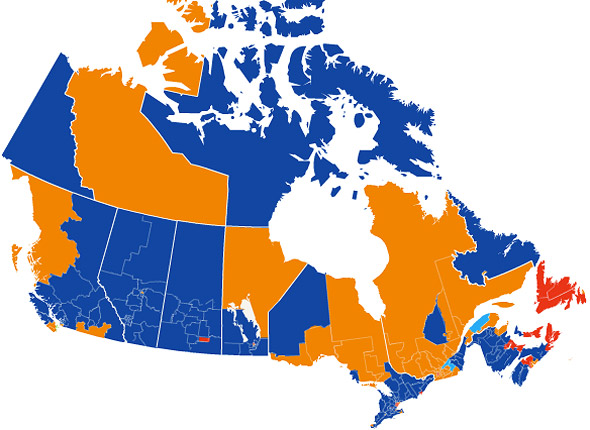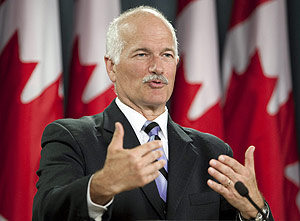| The Canadian Political Spectrum
The Canada eZine - Politics This Website is Best Viewed Using Firefox
Political Parties of CanadaLAST UPDATED MAY 4th 2011. Following the results of May 2nd's general federal election we have created this breakdown of Canada's political spectrum and organized it in a way so its easy to navigate. We have done this in the past for previous elections. You can click on the names of political parties below in the spectrum to navigate faster to the one you want to see. The numbers below the names of each party indicates the number of seats they won in parliament. Below that is the % of Canadians who voted for them on May 2nd 2011. Voter turnout was 61.4%.
The Conservative Party of Canada
Led by Stephen Harper, this right-wing party is the current government as of winning the May 2nd 2011 general election. For the previous 5 years the Conservatives have stagnated in a minority government and were unwilling to make compromises with other political parties. Now that they have a majority government they can force through legislation without any need to consult the other parties. History When the Progressive Conservative Party collapsed following the introduction of the GST, the retirement of Brian Mulroney and the installation of Kim Campbell those changes went over really badly in Western Canada. It led people like Preston Manning to create "The Reform Party" which was an idealogical right-wing party with heavy Christian overtones. The party was popular in Alberta and managed to win 52 seats in 1993, mostly in Western provinces. The problem was that the Reform Party was too idealogical right-wing for the majority of Canadians. They wanted to scrap gun control laws, make abortion illegal, increase military funding, privatize healthcare, cut educational funding and encourage more private schools (ie. Christian schools) and so forth. Their proposed changes scared many Canadians and they were simply unelectable. Since 1993 the Reform Party has changed its name several times, becoming the Canadian Alliance Party (led by Stockwell Day) and later the new Conservative Party (led by Stephen Harper), which gobbled up the remnants of the old Progressive Conservative Party. Having endured several name changes in 2011 they've finally managed to gain a majority government, which will allow the Reform-Alliance-Conservatives to push through their more controversial ideas. Platform
Bloc QuébécoisThe BQ is a Quebec separatist party which wants to turn Quebec into its own country and control its own affairs, operating on a centrist platform. Its known for its somewhat racist views against minority groups (Jacques Parizeau blamed the failed 1995 Referendum on immigrants and natives) and its disgust for anything which is not French, not Catholic and not Quebec. See The Roots of Quebec Separatism. History Founded in 1991, the BQ managed to grab the spotlight in 1993 when it became the official opposition party, which led to the 1995 Referendum on Quebec Sovereignty. The majority of Quebecers voted Non to separatism and since then the popularity of the BQ has fallen. In 2011 they only gained 4 seats in parliament and lost official party status. Pundits are now predicting the BQ will be relegated to the history books. Platform All the BQ wants to do is separate from the rest of Canada. They also want to deter non-French immigrants from coming to Quebec. The Green Party of CanadaThe Green Party is a more environmentally friendly version of the Conservative Party. In theory they're more like the old Progressive Conservative Party than any other. They have been mistakenly been placed on the far left by pundits, but in truth they're right-centrist with the exception of environmental issues. The jist of their platform is to maintain Canada's status quo, but to spend more on environmental issues in an effort to make Canada a greener country. History The Green Party has polled as high as 10% in previous elections, but voters wise has never gotten over 6.78% of the popular vote (2008). They've only had 2 MPs ever, 1 who defected after 2008 after being thrown out of his party, and Elizabeth May, the Green Party leader who finally managed to win her own seat in May 2011. They've never even been elected in a province and lack experience. The Green Party has never even gained "official party status" by getting 12 seats in parliament. Its doubtful they will any time soon. Platform Really the only significant item on the Greens platform is lots of environmental spending. The Liberal Party of CanadaThe Liberal Party is one of the oldest parties in Canada. So old they've become traditional and stuffy. They used to be a left-wing party but have over time become more and more centrist in their values. They've become too moderate and too status quo in recent years, the result of efforts of trying to please the moderate-centrist voters. Sadly not many moderate voters voted in the May 2011 election and they've been reduced to a mere 34 seats. Liberal leader Michael Ignatieff has resigned and its expected his replacement (currently touted to be Bob Rae) may decide to try a merger with the NDP. History The Liberals have been a constant in Canadian politics up til now. During the 1990s and early 2000s the Liberals were led by Jean Chretien, Canada's most popular prime minister ever. During that golden time the Liberals worked towards paying off the national debt, had a strong and stable economy, and was making slow progress on health care and environmental issues. Platform Maintain the status quo, with the exception of maintaining a strong economy, improving health care and small increments of environmental spending. The New Democratic Party of Canada
The NDP is led by Jack Layton (update: Jack Layton died on August 22nd 2011) and his popularity is growing. Some people even call it "Layton-mania", a reference to the old Trudeau-mania. Popular with women voters, young people and anyone who is leftwing, the NDP has finally managed to get out from behind the Liberal shadow and has now grabbed the official opposition with 102 MPs in parliament. There is even talk of a merger with the old Liberal Party which has become a dinosaur on the verge of extinction. Update: With the death of Jack Layton the leadership of the NDP is currently unclear. We will be updating this page after a period of mourning and a NDP leadership convention. History Founded in 1961 and led by then Tommy Douglas, the NDP is the reason Canadians still have free health care in Canada. The NDP was popular during the 1960s and 1970s, but faded in the late 80s and 90s during a time when the Liberals were very popular. Under the leadership of Jack Layton since 2003 the NDP has since seen a resurgence in popularity and is now the official opposition. Platform
Minor Political Parties of Canada
See Also: Is Multiculturalism in Canada dead? Standing up for Public Education in Ontario
|
|
||||||||
|
|
|||||||||
Website Design by Charles Moffat


